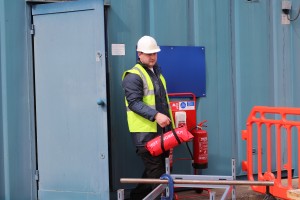Recently added item(s)
You have no items in your basket.

In part one of this two-part blog, we look at the fire risks on construction sites and how best to detect and warn the workforce of a fire on site.
The risk of fire and the severity of its consequences is magnified when a building has missing or reduced fire precautions measures and especially when high risk tasks and materials are present on site.
As a result, by their very nature construction sites - be they new build or simply the refurbishment or alteration of an existing building - have a higher risk of fire and greater loss as a result.
Hot work, the introduction of flammable liquids and gases, plant, and machinery, plus a diverse workforce from several different trades and companies all increase the risk of fire. In addition, missing passive fire protection (including incomplete walls, doors, unfinished and unstopped cable/pipe runs) and minimal active fire protection (verbal fire warning, insufficient or empty extinguishers, unfinished sprinklers and rising mains, no emergency lighting) can all contribute to a worse outcome once a fire occurs.
The Health & Safety Executive (HSE) has updated HSG 186 – Fire Safety in Construction this year (2022) and this should be the primary reference point for those responsible for fire safety on site.
All persons with duties under the Construction (Design and Management) Regulations 2015 must contribute to good fire risk management and legal compliance. The process starts at the design stage where fire safety both during and after construction needs to be considered.
Fire Risk Assessments are also required by the Regulatory Reform (Fire Safety) Order 2005 (FSO) which applies in England and Wales and the Fire (Scotland) Act 2005 (FSA) in Scotland.
Not to be forgotten are The Dangerous Substances and Explosive Atmospheres Regulations 2002 (as amended in 2015) (DSEAR) which place duties on employers to prevent fires and explosions arising from work with dangerous substances. Examples include flammable liquids and gases, gases under pressure, organic dusts, and corrosive substances. Employers must assess the risks and mitigate the consequences should they occur.
As part of the risk assessment, it should be determined what general fire precautions are required.
Means of fire warning and detection
Early warning to all staff on site is essential. However, it’s not uncommon for some sites to have nothing beyond verbal warning or a rotary alarm, gong or air horn. These, along with self-contained combined manual call point/sounders, may actually suffice for the smallest sites where a single warning device can be heard at sufficient audibility throughout the site, however it’s not long before a single device is insufficient – especially when you consider the background noise of plant and equipment and the use of ear defenders/ear plugs.
Modern fire alarm technology and the advances in radio technology now allows the long-standing self-contained manual call point/sounder to become part of a full wireless fire alarm system with units being wirelessly linked across a site, even with the potential in larger systems for zoning to a central control unit. Visual warnings are incorporated into many units (ideal for high noise/ear PPE environments) and some even have the ability to include first aid/accident alarms. Automatic fire detection, once only possible locally using battery operated smoke alarms, can also be included in many systems.
If you are equipping a relatively small site the self-contained manual call point/sounder is preferable to rotary gongs or air horns as once activated it frees up the person sounding the alarm to evacuate, attack the fire or assist colleagues as required.
Whatever the size and complexity of system used it’s important that staff know how to use it, what to do if it sounds and also vital it is regularly tested and maintained.
In part 2, we will look at the best means of fighting a fire should one break out on site.
Fire Depot has been the UK's favourite fire safety supplier for over 50 years, we know the fire protection and prevention business inside out. Our experienced team can offer advice and guidance about any of our fire safety products. For expert help and advice, please contact the Fire Depot team on 0330 999 2233, email us at sales@firedepot.co.uk or visit https://www.firedepot.co.uk/ to see our full range of fire safety products.
The information contained within this blog is provided solely for general informational and educational purposes and is not intended as a substitute for professional advice. Before taking any actions based upon this information, we advise the reader to consult any and all relevant statutory or regulatory guidance and where felt necessary to consult a qualified fire or industry regulation professional. The use or reliance on any information contained herein is solely at the reader’s risk.